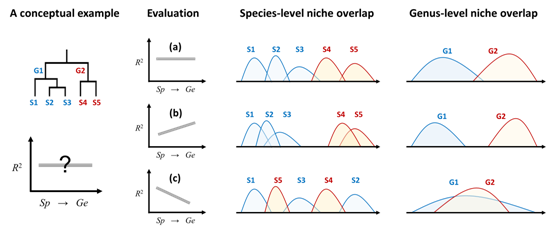Explore evolutionary forces underlying community assembly by tracking the strength of community-environment relationships at fine to broad taxonomic resolutions.
Hsiao-Pei Lu and Chih-hao Hsieh
Institute of Oceanography, National Taiwan University
Species is considered as the fundamental unit for ecological studies. Nevertheless, it is notable that living organisms are hierarchically organized: individuals can be classified into species, species into genera, genera into families, and so on. Previous studies on environmental assessments have found that the detectedstrength of community-environment relationships varies depending on the resolution of taxonomic classification, with the best resolution differing for targeted organisms and/or study regions. However, the underlying mechanisms explaining whythe best performance of taxonomic composition data is not always at the species levelhave not yet been fully elucidated.
To fill this knowledge gap, the research team, led by Hsiao-Pei Lu and Chih-hao Hsieh from the Institute of Oceanography, National Taiwan University, proposes a novel method to explore the potential influences of evolutionary processes driving community organization by systematically quantifying community-environment relationships with taxonomic data at fine to broad resolutions. Using microbial community datasets from diverse ecosystems and geographic regions, they demonstrate that analyzing multi-level taxonomic data instead of focusing on a single taxonomic level is able to provide additional evolutionary insights into contemporary ecological patterns. This work is published inThe ISME Journal (Dec, 2016).
The team develops a method to bridge the concepts rooted in phylogenetic systematics and community ecology, illustrating that the strength of the community-environment relationship might (a) remain, (b) increase, or (c) decrease when grouping species into broader taxonomic units, depending on niche overlap patterns among phylogenetically related taxa (Figure 1). If species of the same lineage generally retain their ancestral traits and exhibit similar responses to environmental factors, the strength of community-environment relationships would remainconstant using either fine or broad taxonomic data (Figure 1a). Moreover, under strong niche conservatism, the niche-related signal might even increase with broadening taxonomic resolution, especially if broader taxonomic units that combine occurrences and abundances of ecologically equivalent taxa can balance the inherent spatiotemporal randomness of finer units (Figure 1b). By contrast, if species tend to diverge greatly in habitat preferences over evolutionary time, broadly-resolved classifications combining finer taxa with distinct environmental responses would lose their ability to detect ecologically meaningful patterns (Figure 1c).
The researchers collected diverse microbial community datasets and associated environmental measurements from soil and seawater samples to evaluate whether niche-related signals remain, strengthen, or vanish when changing taxonomic resolution. The results indicate that microbial community dynamics is significantly driven by environmental variability and niche-related signals are strengthened with broadening taxonomic resolution from species to order or even phylum level. These findings support the niche conservatism hypothesis and reinforce the current notion of ecological coherence in deep evolutionary branches of microbes.
Figure 1. A conceptual scheme for exploring the evolutionary effect regarding niche conservatism or niche divergence on community assembly.In this example, there are 5 species (S1-S5) belonging to 2 genera (G1 and G2). When grouping species into genera for analyses, the strength (R2) of the community-environment relationship might (a) remain, (b) increase, or (c) decrease, depending on niche overlap patterns. In the (a), species of the same genus exhibit similar responses to the environment; thus, genus-level community data would detect the niche-related signal as strong as specie-level community data. In the (b), species within the same genus show a high overlap in their niche preferences; thus, genus-level community data would detect a strengthened niche-related signal. In the (c), species of the same genus exhibit distinct responses to the environment; thus, genus-level community data would detect a diminished niche-related signal.
Reference:
Hsiao-Pei Lu, Yi-Chun Yeh, Akash R Sastri, Fuh-KwoShiah, Gwo-Ching Gong and Chih-hao Hsieh (2016)Evaluating community-environment relationships along fine to broad taxonomic resolutions reveals evolutionary forces underlying community assembly. ISME J. 10, 2867–2878.
http://www.nature.com/ismej/journal/v10/n12/abs/ismej201678a.html











